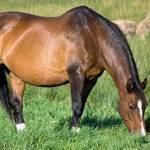Fescue Facts

Problems associated with fescue are recognized among nutritionists and breeders alike. Mares allowed to graze fescue during late pregnancy may encounter one or more signs of a syndrome called “fescue toxicosis.” Signs include prolonged gestation, sometimes up to 13 or 14 months, and foaling difficulties that may include thickened placenta and a “red bag” emergency that typically requires human intervention if the foal is to survive. Another significant problem associated with fescue toxicosis is low milk production or a complete lack of milk.
Fescue found in fresh pasture, especially in early and late spring, usually harbors the endophyte (or fungus) Acremonium coenophialum. It is this endophyte that causes the problems in pregnant mares. Aside from fresh pasture, mares may come into contact with the endophyte by less well-known means: hay and bedding.
Grass hay is rarely pure. With the exception of popular forage types such as timothy or orchard grass, which may approach a higher level of purity, grass hay is more often than not described as “mixed.” If it is purchased from an unknown buyer, a mixed grass hay may include fescue, and that fescue might be infected with fungus.
Therefore, when purchasing hay for pregnant mares, be sure it is free of fescue. If fescue is discovered, double-check that the plants were harvested from an endophyte-free stand. If this cannot be ascertained definitively, the hay should be disregarded as it is inappropriate to feed to late-pregnant broodmares.
Some forage that is unsuitable for consumption by horses ends up being used as bedding. This is a common practice on large farms where many mares are given fresh bedding each night or when straw is in short supply. Because of its poor nutritional quality, fescue is sometimes chosen as such bedding.
In some circumstances, mares may consume the bedding, putting themselves at risk for fescue toxicosis. While horses will generally gravitate toward high-quality forage, it is not unusual for some to chomp through a fair amount of bedding. In fact, more than a few horses cannot be bedded on straw because of their penchant for consuming this seemingly bland-tasting forage. As a precaution, an experienced agronomist or other specialist should inspect inferior forage before it is used to bed down the stalls of mares in late gestation.
Further, used bedding that has been stripped from stalls should not be strewn on fields grazed by mares. Seed may fall from dried plants and germinate in the field, thus contaminating the fields and giving cause for complete renovation of pasture areas, if they’re to be used for grazing mares.
The endophyte that causes problems in late gestating mares has been identified in fresh fescue, fescue hay, and poor-quality dried fescue used as bedding. Be sure to keep mares away from fescue if its source is unknown.








